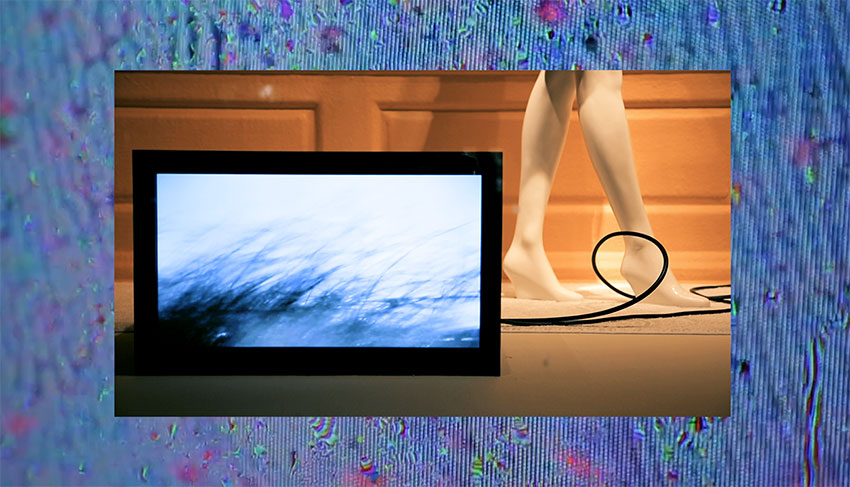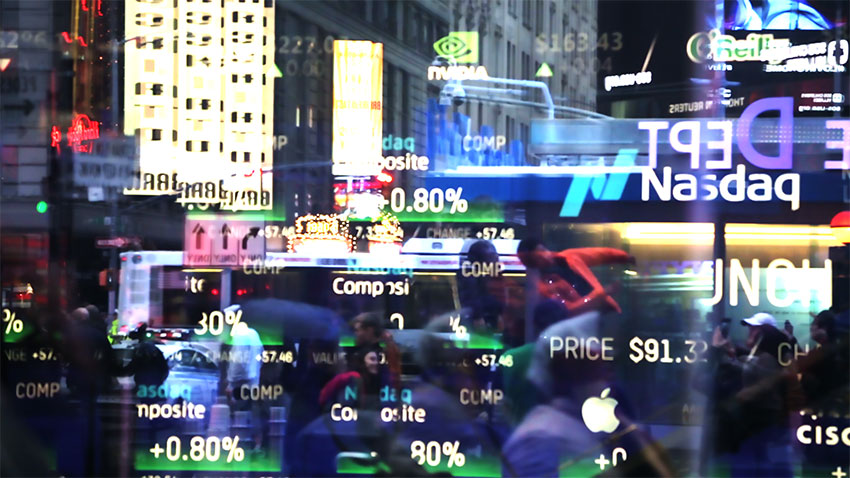Interview Nikita Ephanov

Experimental composer, producer, and installation artist Britton Powell blends mixed media to expose the minutiae in ritual. His ambient-grounded sonics draw upon non-western rhythms, minimalism, and unorthodox percussion. As a participant in the experimental music scene, he’s collaborated with the likes of Jon Hassell, Matmos, Lucy Railton, Jon Gibson, and Huerco S, as well as recently touring with famed electro-acoustic artist Fennesz.
Based in Brooklyn, his latest work, If Anything Is, reflects upon city life at a confluence with capitalist accelerationism. Filmed in notable locations such as the excessively enterprise-satiated Times Square, the work initiates a meditative conversation between the mundane and the hyperreal. Blips of percussive beats puncture scenes into momentary standstills of commercial storefronts, city-dwellers, and electric infrastructure. Groaning synths, fuzz, and drones enwrap, diverting back to the temporal nature of an ever-evolving post-capitalist state.
If Anything Is ruptures and flows; a tidal experience highlighting the rituals of 21st-century existence. Powell extensively tours as a performance artist and musician, evading the industry’s neat label run-release schedules standard. While releasing his work through the experimental label Catch Wave Ltd, which he concurrently runs, Powell reflects and interacts with an intriguing circle of sound and video artists.
The musician exhibits a loose, conversational relationship with time, manifested through organic visual cues and abnormal polyrhythms drawn from African and Asian musical traditions. His work evokes tensions explored by Jon Hassell; it arrives as no surprise that he collaborated on 2018’s Listening to Pictures. Both artists utilise the non-linear dynamics of ethnographic music and friction their work with a futuristic, electronic gleam.
In examining the mega-capitalist grounds of his home base in New York, Powell’s If Anything Is confronts the rituals of post-capitalist America. Through enterprise, technology; is a momentous drive of capital advancement. Exploring such themes establishes a unique departure from the pastoral or cosmic tendencies of other musicians drawing upon ethnographic influences. Although the pandemic has halted his touring schedule, Powell’s works can still be seen as self-contained installations. He seeks to resume touring in 2022.

You are an experimental composer and producer working with electronics, video and percussion. What is your creative process like? Is it similar when you work with sound or visual media?
It’s important to get lost. When I create work, I really need to lose my bearings in the process. The wheels need to come off in some unknown place: Fear, electricity, confusion. They all need to be there. I also need to feel pushback from the work itself. I like the feeling of being out of control a bit, feeling like someone else has their hand on the wheel. Maybe like the Ouija glass is moving a bit. Whether it be sound or film, or anything really, it needs to jump back at me as if it was someone other than myself creating it. If I see or hear too much of me in the work, I get bored; I’m really after something that feels physical and present and of its own character.
Your most recent album, If Anything Is, explores themes of hyper-reality and accelerated capitalism. Could you tell us more about the intellectual process behind it? What drove your interest in exploring these topics?
This has been an insane project to undertake over the last year and a half. Just to give a brief background, the project is a performance piece or installation that features multimedia video and sound. The video component was essentially just a survey of “modern” life in New York City in 2019. The imagery shows the digital landscape of storefronts, hyperreal architecture, and all the people that ornament these places.
The editing of the video features a lot of superimposition (mostly in camera), as well as stroboscopic editing techniques, which marry all of these different scenes and themes pretty intensely.
What’s interesting to me about the piece is that so much of what we were documenting and exploring in the images has come to a complete standstill or basically has been turned off, which is pretty surreal. It’s almost like we filmed the foam of a big wave on the sand just as it’s about to retreat back into the ocean.
Ultimately I think that’s maybe why the piece was made, to show the last glimmer of a certain type of culture before everything was shut down to a grinding halt and reborn. What’s really amazing to me is how so many of the storefronts that we shot have now been boarded up and looted, haha. Amazing. It’s like we captured the last minute of a snowglobe falling in the air just before it hits the ground and smashed to bits.
What does your personal hyper-real world look like?
The hyperreal is very vivid, especially internally, in my thoughts. It’s crazy and colourful. I try to imagine 10 or 20 years ago what my thought process was like or what my relationship with time, culture and technology was like, and in some ways, they are kind of impossible to imagine. What is possible is continually evolving. The framework for society is changing so rapidly, and I feel like that framework moulds my synapses. It’s hard sometimes to imagine how my thoughts used to travel. Time definitely moved differently then…so amazing to project how much that will change in 5 to 10 to 20 years from now; we’re definitely in for a ride.
What were you exploring more at the technical level in the new album? What were the biggest challenges for it?
Lighting was a fun challenge that we ran into for filming in these environments. We filmed a lot in Time Square at sunset, which was incredibly beautiful but challenging to capture. There’s a lot to take in there, and the light is always dancing. Also, editing film – wow, so fucking crazy. You can spend 12 hours in a minute and a half easily. There’s so much fatigue involved with doing so very little; it’s amazing. There were some definite growing pains there. A feeling I wasn’t used to. Looking forward to exploring the medium further. I’ve got notebooks full of ideas. So many things I want to see that I’ve never seen.
If Anything Is, is designed as well, a mixed-media environment for sound and multichannel video, which you were planning to use for your live sets. What bridges together the sound and the visual part?
So yeah, I had 30 or so performances lined up for the spring of 2020, and we got to perform five of them. The rest have either been postponed and/or cancelled. It’s an interesting piece as it’s flexible; it can be either an installation or performance work. It’s actually being shown at a contemporary art museum in Belgium this upcoming weekend while I’ll be here in NYC. I imagine the sound being the glue that ties the images together, the thing in the air that connects all of these disparate scenes.
You’ll hear a lot of amorphous long pulsating drones ornamented by these small percussion phrases that are repeated and cut up in different ways. The electronic sounds reflect the glaze of LED walls reflected on the street corners on a rainy day, or the white light reflected onto the faces of strangers walking by staring at their cellphones. I like the idea of commerce as a ritual, and when hearing these acoustic percussion patterns beat away paired with that. It ties sounds and rituals that are much more ancient and analogue – I like friction between these two things, the images of contemporary digital sparkle and the sounds of wood and metal being pounded away on.
You live in NYC city, where the images for the video were filmed. What role plays (or has played) the city in your artistic practice?
I think NYC is just insane. I love it. I’ve lived here for six years now and have been coming since I was 17 or so. The sound world here is so physical; from dripping and buzzing machines all around you, to languages from all over the world, to all the music playing on the streets – it’s a symphony city. I recently was in the Grand Canyon, and I couldn’t believe how still the soundworld was; it actually kind of startled me. You’re always bathing in sound here. Also, the multicultural aspect of the city is hugely influential; the history of the city is also huge for me. I love that it’s a walking city as well. That I can step outside of my apartment, take a stroll, and end up on a street I’ve never been down is really inspiring.
The album was recorded in 2019 when a good amount of us had the sense of this ultra-accelerated capitalist world. What are your reflections on the album topics after 2020?
I think it’s a really exciting time right now. There’s a lot of fog in the air, and it feels like a lot of people are in anchorless water, especially here in the States. I think it’s a great time for everyone to consider how natural this kind of shift is. Loss, surprise, change – it’s all very natural in a certain way. Personally, I welcome putting the brakes on where things were seemingly headed. We need significant changes across the board. Upheaval. We’re on a highway to hell, for sure. Freaking out a bit; yeah, that’s good. We need more of that. It’s definitely time to explore new possibilities and change in any direction.
You were also a part of Jon Gibson’s new ensemble; What has working with him brought to your practice, and what were the more significant learnings? Did it change your take on minimalism?
Jon’s amazing. He’s such a profound musician and such a gentle soul. I’ve learned a lot from his grace. I think working with him, and hearing his stories of working with Glass, La Monte, Riley, and Reich, gave me a lot of perspective on how insanely dedicated all these people were to their work. Jon’s also very much in tune with nature; he shared that spirit with me.
When we would tour, he would sit outside of the hotels in the morning and listen to the birds. It was a real thing for him to experience those natural surroundings in a deep way wherever we were. He would talk about listening to their calls in a meaningful way, like truly blown away by the sounds, and that was super touching.
What’s your chief enemy of creativity?
Sleeping.
You couldn’t live without…
Dreaming.






